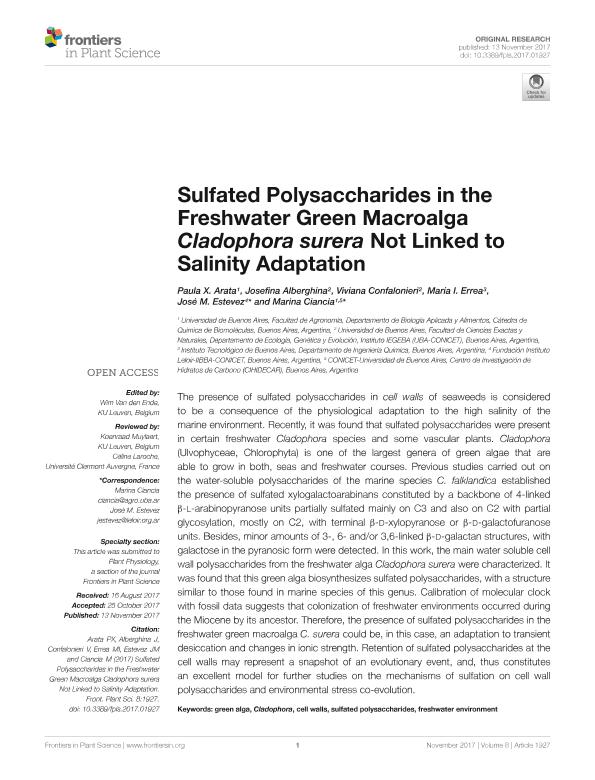Mostrar el registro sencillo del ítem
dc.contributor.author
Arata, Paula Ximena

dc.contributor.author
Alberghina, Josefina Silvia

dc.contributor.author
Confalonieri, Viviana Andrea

dc.contributor.author
Errea, María Inés

dc.contributor.author
Estevez, Jose Manuel

dc.contributor.author
Ciancia, Marina

dc.date.available
2018-02-28T20:40:53Z
dc.date.issued
2017-11
dc.identifier.citation
Arata, Paula Ximena; Alberghina, Josefina Silvia; Confalonieri, Viviana Andrea; Errea, María Inés; Estevez, Jose Manuel; et al.; Sulfated polysaccharides in the freshwater green macroalga cladophora surera not linked to salinity adaptation; Frontiers; Frontiers in Plant Science; 8; 11-2017; 1-10
dc.identifier.uri
http://hdl.handle.net/11336/37495
dc.description.abstract
The presence of sulfated polysaccharides in cell walls of seaweeds is considered to be a consequence of the physiological adaptation to the high salinity of the marine environment. Recently, it was found that sulfated polysaccharides were present in certain freshwater Cladophora species and some vascular plants. Cladophora (Ulvophyceae, Chlorophyta) is one of the largest genera of green algae that are able to grow in both, seas and freshwater courses. Previous studies carried out on the water-soluble polysaccharides of the marine species C. falklandica established the presence of sulfated xylogalactoarabinans constituted by a backbone of 4-linked β-L-arabinopyranose units partially sulfated mainly on C3 and also on C2 with partial glycosylation, mostly on C2, with terminal β-D-xylopyranose or β-D-galactofuranose units. Besides, minor amounts of 3-, 6- and/or 3,6-linked β-D-galactan structures, with galactose in the pyranosic form were detected. In this work, the main water soluble cell wall polysaccharides from the freshwater alga Cladophora surera were characterized. It was found that this green alga biosynthesizes sulfated polysaccharides, with a structure similar to those found in marine species of this genus. Calibration of molecular clock with fossil data suggests that colonization of freshwater environments occurred during the Miocene by its ancestor. Therefore, the presence of sulfated polysaccharides in the freshwater green macroalga C. surera could be, in this case, an adaptation to transient desiccation and changes in ionic strength. Retention of sulfated polysaccharides at the cell walls may represent a snapshot of an evolutionary event, and, thus constitutes an excellent model for further studies on the mechanisms of sulfation on cell wall polysaccharides and environmental stress co-evolution.
dc.format
application/pdf
dc.language.iso
eng
dc.publisher
Frontiers

dc.rights
info:eu-repo/semantics/openAccess
dc.rights.uri
https://creativecommons.org/licenses/by-nc-sa/2.5/ar/
dc.subject
Cell Walls
dc.subject
Cladophora
dc.subject
Freshwater Environment
dc.subject
Green Alga
dc.subject
Sulfated Polysaccharides
dc.subject.classification
Otras Ciencias Biológicas

dc.subject.classification
Ciencias Biológicas

dc.subject.classification
CIENCIAS NATURALES Y EXACTAS

dc.title
Sulfated polysaccharides in the freshwater green macroalga cladophora surera not linked to salinity adaptation
dc.type
info:eu-repo/semantics/article
dc.type
info:ar-repo/semantics/artículo
dc.type
info:eu-repo/semantics/publishedVersion
dc.date.updated
2018-01-12T19:27:25Z
dc.identifier.eissn
1664-462X
dc.journal.volume
8
dc.journal.pagination
1-10
dc.journal.pais
Suiza

dc.description.fil
Fil: Arata, Paula Ximena. Universidad de Buenos Aires. Facultad de Agronomía. Departamento de Biología Aplicada y Alimentos. Cátedra de Química de Biomoléculas; Argentina
dc.description.fil
Fil: Alberghina, Josefina Silvia. Consejo Nacional de Investigaciones Científicas y Técnicas. Oficina de Coordinación Administrativa Ciudad Universitaria. Instituto de Ecología, Genética y Evolución de Buenos Aires. Universidad de Buenos Aires. Facultad de Ciencias Exactas y Naturales. Instituto de Ecología, Genética y Evolución de Buenos Aires; Argentina
dc.description.fil
Fil: Confalonieri, Viviana Andrea. Consejo Nacional de Investigaciones Científicas y Técnicas. Oficina de Coordinación Administrativa Ciudad Universitaria. Instituto de Ecología, Genética y Evolución de Buenos Aires. Universidad de Buenos Aires. Facultad de Ciencias Exactas y Naturales. Instituto de Ecología, Genética y Evolución de Buenos Aires; Argentina
dc.description.fil
Fil: Errea, María Inés. Instituto Tecnológico de Buenos Aires. Departamento de Ingeniería Química; Argentina
dc.description.fil
Fil: Estevez, Jose Manuel. Consejo Nacional de Investigaciones Científicas y Técnicas. Oficina de Coordinación Administrativa Parque Centenario. Instituto de Investigaciones Bioquímicas de Buenos Aires. Fundación Instituto Leloir. Instituto de Investigaciones Bioquímicas de Buenos Aires; Argentina
dc.description.fil
Fil: Ciancia, Marina. Universidad de Buenos Aires. Facultad de Agronomía. Departamento de Biología Aplicada y Alimentos. Cátedra de Química de Biomoléculas; Argentina. Consejo Nacional de Investigaciones Científicas y Técnicas. Oficina de Coordinación Administrativa Ciudad Universitaria. Centro de Investigaciones en Hidratos de Carbono. Universidad de Buenos Aires. Facultad de Ciencias Exactas y Naturales. Centro de Investigaciones en Hidratos de Carbono; Argentina
dc.journal.title
Frontiers in Plant Science
dc.relation.alternativeid
info:eu-repo/semantics/altIdentifier/url/http://journal.frontiersin.org/article/10.3389/fpls.2017.01927/full
dc.relation.alternativeid
info:eu-repo/semantics/altIdentifier/doi/http://dx.doi.org/10.3389/fpls.2017.01927
Archivos asociados
